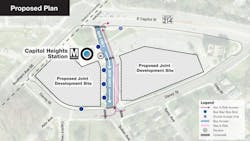TOD developments progress at JTA, WMATA, city of Sacramento, Calif.
Transit-oriented developments (TODs) are bringing affordable housing to communities in Jacksonville, Fla., Capitol Heights, Md., and Sacramento, Calif., connecting them to transit and increasing access to jobs, housing and other amenities in the area.
The Jacksonville Transportation Authority authorized two long-term ground leases agreements to bring more workforce housing to downtown, and the Washington Metropolitan Transportation Authority (WMATA) published a Request for Qualifications (RFQ) for its Capitol Heights Metro Station, one of four stations included on the Blue Line corridor initiative. Meanwhile, a $38 million grant was award from California’s Affordable Housing and Sustainable Communities (AHSC) program to the Capital Area Community Development Corportation (CACDC) and Mutual Housing California partnership to deliver affordable housing in the city of Sacramento.
JTA adds workforce housing to downtown area
The two TODs are in partnership with Corner Lot Development, located at a one-acre parcel at the corner of Montana Avenue and Manning Street, and with Gateway Jax at the eastern portion of the Rosa Parks Transit Station, a 1.47 site at 201 West Union St.
"With these transit-oriented developments, we are helping to make downtown Jacksonville more walkable with better access to jobs, housing and public transportation for people of all ages and incomes," said JTA CEO Nat Ford.
Forty percent of the Montana Avenue/Manning Street 186-unit development will be workforce housing at 80 percent of area median income (AMI) while 15 percent of the Rosa Parks 250-unit TOD will be workforce housing at 120 percent of AMI.
"We at Corner Lot look forward to collaborating with the Jacksonville Transportation Authority on another transit-oriented development with the Manning Street and Montana Avenue project,” said Billy Zeits, vice president of government relations and external affairs, Corner Lot. "As we learned with our previous partnership on Artea at Southbank, which is close to completion, these collaborations take time to evolve but are absolutely achievable. We want to thank the JTA Board of Directors and staff for their vision of identifying partners to find housing solutions in the city of Jacksonville. We are excited about the positive impact this project may bring, creating new opportunities and strengthening Jacksonville’s growth for the future."
Gateway Jax CEO Bryan Moll added, "We are committed to investing and developing in downtown Jacksonville. A world-class downtown requires considerable density and a mixture of uses in its urban core. The residential and retail uses we are proposing immediately to the east of the Rosa Parks Skyway Station will be another exciting step in achieving that shared vision. We look forward to adding this mixed-use project to our portfolio, which will encourage even more families and individuals of all income levels to call downtown their home."
Both the TODs will make use of the automated elevated people mover, the Skyway, which is being converted to an autonomous vehicle roadway through the Ultimate Urban Circulator (U2C).
"A few years ago, the JTA declared it was ready to transform its lazy assets into placemaking opportunities for our riders and the private sector,” said Cleveland Ferguson III, executive vice president and chief administrative officer, JTA. "We are pleased that the developer community sees the value of public transportation and is using our U2C TOD planning studies and forming partnerships to create sustainable housing and pedestrian-centric amenities."
In addition, the Montana and Manning development will not feature on-site parking. Connectivity will be exclusive to the existing Kings Avenue Parking Garage and Kings Avenue Skyway station. This development has the potential for commercial and recreational improvements.
The Rosa Parks development will utilize a portion of the adjacent parking garage owned by Gateway Jax at 712 Hogan St. In addition, a portion of the 30-mile Emerald Trail will be constructed on the property.
JTA says both projects will be leased for 99 years, with substantial completion targeted during the next 36 months.
WMATA seeks developer to create sustainable, vibrant communities along Blue Line corridor
WMATA hopes to transform the approximately 5.5-acre property to provide new housing, neighborhood-serving retail and improve connectivity adjacent to transit with regional accessibility. After selecting a developer, WMATA will negotiate a joint development agreement allowing the selected company to develop the site.
In spring of this year, Maryland State Delegate Jazz M. Lewis (D-24) announced the state’s $17 million commitment toward transit and site infrastructure to help facilitate and advance development at the Capitol Heights station. Earlier this year, WMATA, Prince George’s County and the town of Capitol Heights executed a Memorandum of Understanding to commemorate a partnership for this opportunity.
The Capitol Heights Station is an integral part of Prince George’s County Blue Line Corridor vision, a consolidated planning effort to catalyze growth and further private investment between Capitol Heights and Downtown Largo. In advancing this vision, the state of Maryland has provided $450 million to construct a range of new signature facilities along the corridor, including an amphitheater, market hall, central library and cultural center, civic plaza, youth sports fieldhouse, complete streets infrastructure and the Central Avenue Connector Trail.
This RFQ is the fourth of five joint development solicitations expected to be released this year, as WMATA leverages its real estate holdings to generate revenue, build ridership and create new tax revenues for local and regional partners.
“The value that joint development brings not only to [WMATA], but to the region, is immeasurable,” said WMATA General Manager and CEO Randy Clarke. “Through transit-oriented development we are building livable, walkable communities, cultivating a new generation of transit users, supporting sustainability and connecting people to jobs.”
Since issuing its 10-year Strategic Plan for Joint Development in April 2022, WMATA and its joint development partners have broken ground on six residential buildings throughout the region, totaling approximately 1,900 units including 1,100 affordable units. WMATA also broke ground on the redevelopment of its original headquarters at Gallery Place, which the agency says will generate $136 million in new district tax revenue over 30 years. WMATA expects to execute up to five new joint development agreements this year, with a goal of 20 new agreements by 2032.
Since 1975, WMATA has completed 57 joint development projects, totaling 17-million-square feet. Several projects recently completed include three new WMATA office buildings in the district; New Carrollton in Prince George’s County and Eisenhower Avenue in Alexandria, Va.; the CODA on Half Street; a 161-unit residential building at Navy Yard Metro; and three solar energy installations at Anacostia, Southern Avenue and Naylor Road stations.
In addition to the Capitol Heights Metro Station property, new development solicitations were released earlier this year for Eisenhower Avenue, Deanwood and North Bethesda Metro stations. An additional solicitation is anticipated for the Brookland-CUA Metro Station later this year.
WMATA’s joint development projects are private developments creating vibrant, mixed-use communities on transit-owned property that may require coordination with transit facilities. By working with developers to integrate transit and community development, joint development brings more jobs, generates property taxes and housing closer to transit, which generates increased transit ridership and helps foster regional partnerships in support of WMATA’s strategic transformation plan.
Interested developers may view the Capitol Heights Joint Development Solicitation on WMATA’s website.
Sacramento area organizations receive funding for affordable housing, transit improvements
The AHSC’s funding award goes beyond housing, with nearly $13 million for Sacramento Regional Transit (SacRT) bus station, bike lane and light-rail station improvements within the Broadway corridor. The transit funding will also go toward a new state-of-the art station and a hydrogen-powered train car for the planned Valley Rail Program ACE passenger rail line connecting Sacramento to Stockton, Fresno and San Jose.
The $25.3 million portion awarded for affordable housing is one of the largest to date for the two Sacramento-based housing and community developers—CACDC, the nonprofit development arm of the Capitol Area Development Authority, and Mutual Housing California. The development, Sakura, will be a 134-unit affordable housing development located at the southwest corner of 16th and T Street in midtown Sacramento, site of a former Warren Brake and Suspension auto repair shop.
The project will consist of studio and one-bedroom units, serving households earning between 30 and 60 percent of area median income. Included on the first floor will be about 2,500 square feet of commercial space along 16th Street.
“There is a vital link between affordable housing and accessible public transportation,” said Henry Li, general manager and CEO, SacRT. “By working together to create more transit-oriented developments, we make housing more appealing and affordable for residents, as they can rely less on cars to get around. This not only reduces traffic congestion on our roads and highways, but also contributes to cleaner air. It's a win-win for everyone.”
Both developers have experience with placemaking and community building—including the recent collaboration with local artists to turn the nearby Monarch project site into a canvas for art that occurred earlier this year.
Sakura will give residents access to resident services and programs that focus on financial literacy, digital skills, health and wellness, leadership development to support their goals and housing stability.
With this funding in place, applications for tax credits have already been submitted. Pending approvals by the California Tax Credit Allocation and Debt Limit Allocation Committees, construction is scheduled to begin by June 2025 with occupancy slated for Summer 2027.
“It is our vision to bring sustainable transportation options to new communities and grow options in our current corridors. Essential to this effort is increasing housing availability around the station areas to provide easy access to our services,” said Pat Hume, San Joaquin Joint Powers Authority chair and Sacramento County supervisor. “Partnering with the Capitol Area Community Development Corporation and Mutual Housing California on an Affordable Housing and Sustainable Communities grant matches this vision and provides an important community benefit. As a part of this grant, SJJPA will receive $5 million towards a zero-emissions vehicle for future service and $1.6 million for our future Midtown Station.”
About the Author
Megan Perrero
Editor in Chief
Megan Perrero is a national award-winning B2B journalist and lover of all things transit. Currently, she is the Editor in Chief of Mass Transit magazine, where she develops and leads a multi-channel editorial strategy while reporting on the North American public transit industry.
Prior to her position with Mass Transit, Perrero was the senior communications and external relations specialist for the Shared-Use Mobility Center, where she was responsible for helping develop internal/external communications, plan the National Shared Mobility Summit and manage brand strategy and marketing campaigns.
Perrero serves as the board secretary for Latinos In Transit and is a member of the American Public Transportation Association Marketing and Communications Committee. She holds a bachelor’s degree in multimedia journalism with a concentration in magazine writing and a minor in public relations from Columbia College Chicago.

